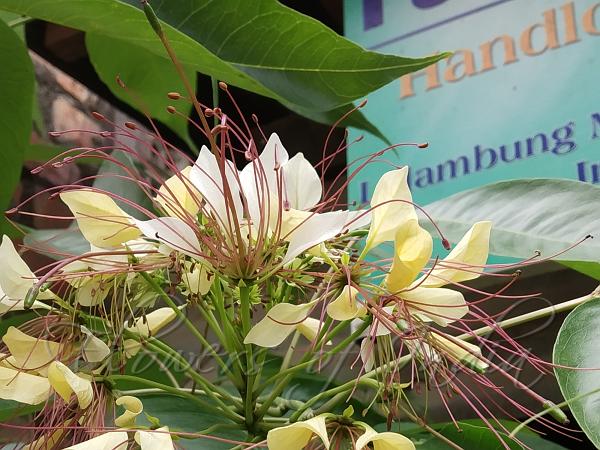|
| Large Garlic Pear |
|

|

| File size | 785484 |
| Original date | 4/27/20 12:33 PM |
| Resolution | 4000 x 3000 |
| Flash | Flash did not fire, auto |
| Focal length | 3.84mm |
| Exposure time | 1/271s |
| Aperture | 2.2 |
| Focus Distance | |
| Metering Mode | Center weighted average |
| Camera make | Xiaomi |
| Camera model | Redmi Y2 |
| Sensor type | OneChipColorArea |
|
|
|
|
Photo: |
Botanical name: Crateva magna Family: Capparaceae (Caper family)
Synonyms: Crateva nurvala, Crateva religiosa var. nurvala, Crateva lophosperma
Synonyms: Crateva nurvala, Crateva religiosa var. nurvala, Crateva lophosperma
Large Garlic Pear is a tee up to 10 m tall, rarely
shrubs, 2-3 m; trunk up to 35 cm in diameter branchlets warty,
greyish-brown, smooth, or verrucose. It is closely related to
Garlic Pear Tree, but has distinctly
larger fruits. Also, Garlic Pear Tree is mostly leafless while flowering,
whereas Large Garlic Pear is very much leafy at bloom time.
Flowers are borne in many-flowered
corymbs at branch-ends; axis 10-15 cm long, growing through axis.
Flowers are creamy, polygamous, faintly fragrant,3-4 cm across;
flower-stalks 3-7 cm long, leaving scars on falling off. Sepals are
oblong to ovate-oblong, pointed, 2.5-3 x 1.3-1.5 cm. Petals are
obovate-blunt, limb 2-2.5 x 1.5-1.8 cm, claw 5-10 mm long. Stamens are
more than 24; filaments 4.5-5 cm long, lilac or purple. Leaves are
trifoliate, carried on 4-12 cm long stalks with glands at tip. Leaflets
are 2-4 times as long as broad, 8-25 x 1.5-6 cm, papery, glossy,
glaucous beneath, brown tinged above; central leaflet
elliptic-Ianceshaped or inverted-lanceshaped; laterals ovate-elliptic
or rhomboidal, pointed to wedge-shaped at base, gradually long-tapering
with a pointed tip; leaflet-stalks are 3-7 mm long. Fruits
oblong-ellipsoid or oblong-ovate, 4-6 x 3-5 cm; pericarp woody,
yellowish grey. Large Garlic Pear is found In
deciduous or semievergreen forests, along streams, at altitudes up to
1000 m, in Peninsular India, Western India, Gangetic Plains and Eastern
India up to Tripura and Manipur. Flowering: January-April.
Medicinal uses: Young fruits are edible.
Leaves are bitter and used in treating skin ailments. Root bark extract
is administered for gastric trouble by Konda-reddis and Valmikis in
Andhra Pradesh.
Young fruits are edible.
Leaves are bitter and used in treating skin ailments. Root bark extract
is administered for gastric trouble by Konda-reddis and Valmikis in
Andhra Pradesh.
Medicinal uses:
 Young fruits are edible.
Leaves are bitter and used in treating skin ailments. Root bark extract
is administered for gastric trouble by Konda-reddis and Valmikis in
Andhra Pradesh.
Young fruits are edible.
Leaves are bitter and used in treating skin ailments. Root bark extract
is administered for gastric trouble by Konda-reddis and Valmikis in
Andhra Pradesh. | Identification credit: V. Ganesan, Dr. Murugan | Photographed in Imphal, Manipur & Coimbatore distt., Tamil Nadu. |
• Is this flower misidentified? If yes,